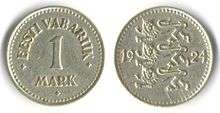Estonian mark
The Estonian mark (Estonian: Eesti mark) was the currency of Estonia between 1918 and 1927. It was initially equivalent to the German ostmark, which had been circulating alongside the Russian ruble since the German occupation. It was divided into 100 penns (in Nominative case: penn). It was replaced in 1928 by the Estonian kroon at a rate of 1 kroon = 100 marka.
Until 1919 there were also Russian rubles, German ostrubles and Finnish marks in circulation.
Coins
Coins were issued in denominations of 1, 3, 5 and 10 marka between 1922 and 1926. The 1922 issues were struck in cupro-nickel whilst the later issues were in nickel-bronze.
Banknotes

In 1919, treasury notes ("kassatäht") were issued in denominations of 5, 10, 20 and 50 penni, 1, 3, 5, 10, 25 and 100 marka along with 50 marka banknotes ("pangatäht"). Later, treasury notes were issued in denominations up to 1000 marka, along with banknotes up to 5000 marka. Exchange notes ("vahetustäht") were also issued, in 1922, in denominations of 10 and 25 marka.
References
- Krause, Chester L.; Clifford Mishler (1991). Standard Catalog of World Coins: 1801–1991 (18th ed.). Krause Publications. ISBN 0873411501.
- Pick, Albert (1994). Standard Catalog of World Paper Money: General Issues. Colin R. Bruce II and Neil Shafer (editors) (7th ed.). Krause Publications. ISBN 0-87341-207-9.